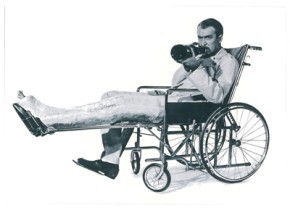Infamous Images – Cinema and Control Society
As its contribution to the Wiener Festwochen (Vienna Festival), the Film Museum will present a comprehensive thematic project consisting of 30 film programmes and a three-day symposium (May 14-16). Infamous Images focuses on issues which determine the present social system in various ways, in terms of politics as well as the media.
The gradual dismantling of the social welfare state has gone hand in hand with a massive increase in surveillance strategies and surveillance media. We are living in an "Era of Control Societies" (Gilles Deleuze), which derive their legitimacy from an all-encompassing security doctrine. The political calculation with fears and uncertainties leads to a vast production of "infamous images". Thanks to video surveillance, public spaces are increasingly becoming areas where police can monitor private citizens at will. The images of infamy produced by such methods do not, however, yield an accurate picture of social realities; they remain a construct of specific technological knowledge, ideology and of the apparatus used in the process. At the same time, video cameras, webcams and data registration machines are becoming omnipresent in the sphere of private life, one more indication that (self-)monitoring has become part of the self-image of our contemporary culture.
The historical connection between film as a recording medium and social engineering as a political technology forms one of the focal points of Infamous Images. Long before the current hype of paranoia, films like Jean Genet's Un Chant d'amour, Hitchcock's Rear Window and Fritz Lang's Mabuse films investigated the dialectic of voyeurism and exhibitionism, dealing with the power of those who see in relation to those who are being seen or want to be seen.
Towards the end of the 1970's, the liberal democracies completed a change from direct to indirect methods of monitoring. Terms such as "internalization" or "normalization" represent a new discourse of government which moves from sanctioning towards motivation. The ideal of "self-realization" corresponds to a logic of paranoia, according to which it is no longer possible for us to know whether our behaviour is being manipulated.
American blockbusters translate this conflict into popular myths and stage epic films around obscure conspiracy theories involving government, computer technology, psychiatry and pharmaceutics, from Brian De Palma's Blow Out and Disney’s Tron in the early 1980s to the more recent Truman Show and Enemy of the State. Socio-psychological models of Interpretation – such as mind control, brainwashing and conditioning – are employed to imagine an omnipresent, anonymous "force of society". In this context, one should remember the historical use of film and video during laboratory-container experiments, such as Stanley Milgrambehaviour study Obedience (1963), and the Stanford Prison Experiment of 1971, led by Phillip Zimbardo. The close ties between the moving image media and experimental observation also point towards a current trend: Reality-TV of the Big Brother type simulates the panoptical surveillance structures of scientific laboratories for today's "confessional animals" (Michel Foucault).
Documentary films like Harun Farocki's Die Bewerbung (The Job Application) show how discourses on performance and management have established themselves as everyday strategies of power. The neoliberal doctrine of "self-government" extends to the innermost areas of private life and increasingly structures all social relationships, as Atom Egoyan's Family Viewing vividly demonstrates.
Films like Helke Sander's Eine Prämie für Irene (A Bonus for Irene), Michael Klier's Der Riese (The Giant) or the Bureau of Inverse Technology's Suicide Box deconstruct the unprecedented campaign of data compilation via video surveillance. They thwart the monitoring gaze and introduce a viewpoint which "looks back". This creation of counter-images heavily depends on "non-monitored" access to the means of production. In the 1980s and 90s, agitprop videos (Züri brennt/Zurich is burning), the medium of Super-8 (Subversive FIlms in The GDR) or the use of found footage (as in Craig Baldwin's films) have figured as exemplary models for this process.
The project "Infamous Images", developed and curated by Ramón Reichert, is taking place with the support of the Wiener Festwochen (Vienna Festival). The symposium is being organized in cooperation with SYNEMA – Society for Film and Media.
